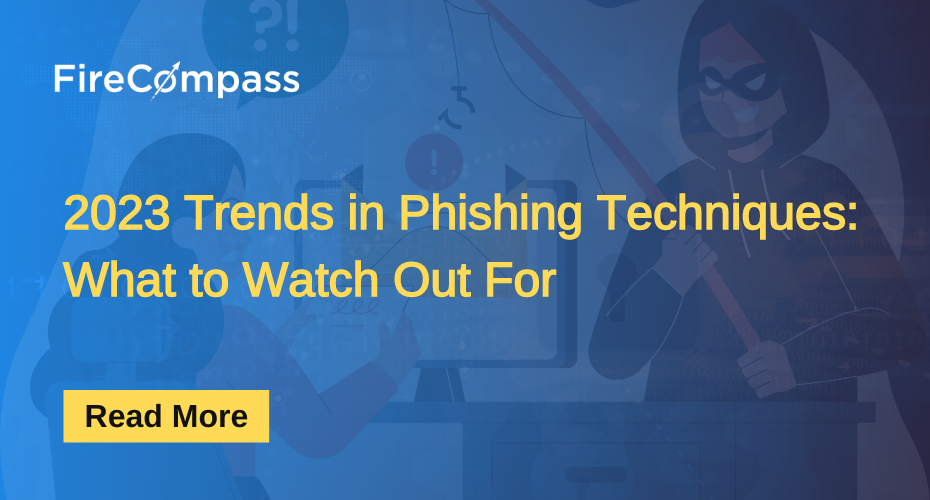2023 Trends in Phishing Techniques: What to Watch Out For
Phishing, a deceptive technique used by cybercriminals, involves tricking individuals into disclosing sensitive information such as passwords, credit card numbers, or personal data. Initially, phishing predominantly relied on unsophisticated emails mimicking legitimate entities. However, it has evolved into a multifaceted threat encompassing various mediums and advanced social engineering tactics.Think of phishing like a digital chameleon—it used to be easy to spot, but now it’s mastered the art of disguise. What started as basic email scams has transformed into something trickier and smarter. As we dive into 2023, understanding this shape-shifting trickster is vital to staying safe online.
What is Phishing
At its core, phishing represents a malicious tactic used by cybercriminals to dupe individuals into revealing sensitive information, such as usernames, passwords, financial details, or other confidential data. It often employs deceptive communication—typically emails, but now expanding to diverse channels—to trick recipients into taking actions that benefit the attackers.
Overview of Phishing’s Evolution
From its humble origins as unsophisticated emails requesting personal information, phishing has undergone a remarkable metamorphosis. Initially, these fraudulent communications were relatively easy to identify due to glaring signs of deception. However, over time:
- Technological Advancements: Phishing tactics have become more sophisticated, utilizing advanced spoofing techniques to create convincing replicas of trusted entities.
- Social Engineering Integration: Cyber attackers leverage psychological manipulation, exploiting human emotions and behavioral patterns to increase the success rate of phishing attempts.
- Adaptability and Innovation: Phishing campaigns continuously evolve, exploiting multiple communication channels beyond email, such as SMS (Smishing), voice calls (Vishing), and social media, to bypass traditional security measures.
- 2023 Outlook: Despite increased awareness and improved security measures, phishing remains an ominous threat in 2023. The fusion of social engineering with diverse communication channels heralds a new era of phishing, challenging cybersecurity defenses and perpetuating risks across digital landscapes.
- The persistent evolution of phishing into a multifaceted threat underscores the necessity for proactive cybersecurity measures and continual vigilance in identifying and mitigating these deceptive tactics.
The Shifting Landscape of Phishing Techniques
1. Social Engineering: Psychological Manipulation in Phishing
In the realm of cyber deception, social engineering reigns supreme. It manipulates human psychology, exploiting emotions and cognitive biases to dupe individuals into divulging sensitive information. Techniques include:
- Pretexting: Crafting fabricated scenarios or personas to gain trust and extract information.
- Phishing with Urgency: Creating a false sense of urgency to prompt immediate action, bypassing critical thinking.Social engineering thrives on human behavior, leveraging trust and emotions to convince individuals to disclose confidential data or perform actions beneficial to attackers.
2. Spear Phishing: Precision in Targeted Attacks
Unlike generic phishing, spear phishing involves highly personalized and precisely targeted attacks. These campaigns tailor messages to specific individuals or organizations, enhancing their credibility and success rate. Key aspects include:
- Research and Personalization: Attackers gather intelligence to personalize emails with accurate details about the recipient, organization, or colleagues.
- Impersonation and Spoofing: Mimicking trusted entities or individuals to deceive recipients into complying with requests.Spear phishing’s precision and customization significantly increase its effectiveness, making it a potent threat for organizations and high-profile individuals.
3. Smishing and Vishing: Phishing Beyond Email
- Smishing (SMS Phishing): Exploiting SMS text messages to deceive recipients into divulging sensitive information or clicking malicious links. Attackers often pose as legitimate entities or services, leveraging the immediacy of SMS.
- Vishing (Voice Phishing): Leveraging voice calls to manipulate individuals into revealing confidential information or executing actions. Callers impersonate trusted entities or use persuasive tactics to elicit sensitive details.
Emerging Trends in Phishing for 2023
1. AI and Machine Learning Integration
As technology advances, so do the tools wielded by cyber attackers. In 2023, the integration of Artificial Intelligence (AI) and Machine Learning (ML) amplifies phishing campaigns:
AI-Driven Phishing Messages: Attackers leverage AI algorithms to generate sophisticated, personalized phishing messages. These messages mimic human speech patterns and contextually adapt to elicit responses.
Evasion of Detection Systems: AI-powered phishing campaigns can circumvent traditional detection mechanisms. ML algorithms learn from successes and failures, enabling attackers to refine their tactics and evade detection by security protocols.
-> Hackers Won't Wait For Your Next Pen Test: Know Automated Continuous Pen Test
2. Exploiting Remote Work Vulnerabilities
The widespread adoption of remote work, accelerated by global events, introduces novel vulnerabilities:
- Targeting Remote Work Infrastructure: Attackers exploit the shift to remote work, leveraging vulnerabilities in virtual private networks (VPNs) or collaboration tools. Phishing attacks masquerade as legitimate communications, exploiting users’ reliance on digital communication channels outside secure office networks.
- Employee Distraction and Fatigue: The blurred boundaries between personal and professional life in remote settings increase susceptibility to phishing. With distractions at home and digital fatigue, individuals may be more prone to falling for deceptive tactics.
3. Cryptocurrency and NFT Scams
The surge in cryptocurrency and Non-Fungible Token (NFT) popularity paves the way for innovative phishing tactics:
- Targeting Crypto Wallets: Phishing attacks exploit the decentralized and pseudonymous nature of cryptocurrency transactions. Scammers pose as legitimate entities, enticing users to reveal wallet credentials or private keys, resulting in financial losses.
- NFT-Related Deception: The burgeoning market for NFTs presents a new avenue for phishing. Scammers entice users with fraudulent offers, claiming exclusive NFTs or enticing them to reveal login details to NFT marketplaces.
In 2023, these emerging trends in phishing underscore the adaptability and innovation of cyber attackers. The integration of AI, exploitation of remote work vulnerabilities, and targeting of cryptocurrency and NFT enthusiasts represent the evolving landscape of phishing tactics, demanding heightened vigilance and updated security measures to thwart these sophisticated threats.
Unveiling the Core Concepts
Request Smuggling: The crux of HTTP smuggling lies in crafting requests that exploit differences in the interpretation of these requests between front-end and back-end servers. This manipulation can result in the smuggling of unauthorized content.
Front-End and Back-End Servers: The front-end server, often a proxy or load balancer, is the first point of contact for incoming requests. The back-end server, on the other hand, is the web server responsible for processing these requests. Discrepancies in how these servers parse HTTP headers and handle connection persistence provide the perfect vulnerable environment for HTTP smuggling attacks.
Advanced Phishing Tactics to Look Out For
1. Zero-Click Attacks
- Understanding Zero-Click Attacks: Zero-click attacks represent a sophisticated evolution in phishing tactics, eliminating the need for user interaction or engagement. These attacks exploit vulnerabilities in software or systems, enabling automatic execution of malicious code upon message receipt or interaction with compromised elements.
- Exploiting Software Vulnerabilities: Cybercriminals leverage zero-click exploits targeting commonly used software, such as email clients or messaging apps. Once a vulnerable system or application interacts with the malicious payload, it triggers the execution of malware or facilitates data exfiltration without user input.
- Prevalence in 2023: The prevalence of zero-click attacks continues to rise in 2023, posing substantial challenges for traditional security measures reliant on user awareness or interaction to mitigate phishing threats.
2. Credential Stuffing and Reuse
- Concept of Credential Stuffing: Attackers leverage stolen username-password combinations obtained from data breaches or phishing attacks on one platform and reuse them across multiple websites or services.
- Automated Credential Attacks: Using automated tools, attackers systematically input stolen credentials across various platforms, exploiting users’ tendencies to reuse passwords across accounts.
- Risk Amplification: Credential stuffing significantly amplifies risks associated with data breaches. With reused credentials, attackers gain unauthorized access to multiple accounts, potentially compromising sensitive personal or corporate data.
Technologies and Solutions to Combat Phishing
1. Email Authentication Protocols
- Sender Policy Framework (SPF): SPF validates email sender addresses by cross-referencing authorized IP addresses. It specifies which servers can send emails on behalf of a domain, preventing email address forgery.
- DomainKeys Identified Mail (DKIM): DKIM adds digital signatures to emails, verifying their authenticity and ensuring messages haven’t been altered during transit. It enhances email integrity by validating the sender’s domain.
- Domain-based Message Authentication, Reporting, and Conformance (DMARC)**: DMARC builds upon SPF and DKIM, offering domain alignment and policy enforcement. It specifies how to handle emails failing authentication checks, allowing organizations to quarantine or reject fraudulent messages.
These email authentication protocols collectively bolster email security, reducing the likelihood of successful email spoofing and phishing attempts.
>>Click Here: To Get The Report Of Gartner Hype Cycle For Penetration Testing & Red Teaming
2. Anti-Phishing Tools and Training
- Employee Training and Awareness: Educating employees about phishing tactics, emphasizing the importance of cautious behavior, and recognizing suspicious emails or communications.
- Simulated Phishing Exercises: Conducting regular simulated phishing campaigns internally to assess employees’ susceptibility and reinforce training with immediate feedback.
- Advanced Anti-Phishing Software: Deploying sophisticated anti-phishing tools capable of real-time scanning, threat detection, and blocking of suspicious emails or malicious links before they reach users’ inboxes.
Regulatory Landscape and Compliance Efforts
1. GDPR, CCPA, and Data Protection Laws
- General Data Protection Regulation (GDPR): GDPR mandates stringent data protection measures for EU citizens’ personal data. Compliance involves implementing robust security protocols, including encryption and data access controls. Adherence to GDPR enhances overall data protection, reducing the risk of data exposure in phishing incidents.
- California Consumer Privacy Act (CCPA): CCPA regulates the collection and use of personal information for California residents. Complying with CCPA requires organizations to enhance data protection measures, limiting the exposure of personal data, which aligns with mitigating phishing risks.
2. Industry Standards and Best Practices
- Healthcare Industry (HIPAA): The Health Insurance Portability and Accountability Act (HIPAA) outlines stringent security standards to protect patient health information. Implementing HIPAA-compliant measures, such as encryption and access controls, fortifies defenses against phishing attacks targeting healthcare data.
- Financial Sector (PCI DSS): The Payment Card Industry Data Security Standard (PCI DSS) mandates secure handling of payment data. Compliance necessitates robust authentication, encryption, and monitoring measures, reducing vulnerabilities to phishing attacks aiming to pilfer financial information.
- Technology and Software Development (ISO/IEC 27001): ISO/IEC 27001 sets standards for information security management systems. Adhering to these standards involves comprehensive risk assessments, ensuring proactive measures against phishing threats within software development cycles.
3. Embracing Compliance for Enhanced Security
- Data Protection as a Shield: Compliance with data protection regulations serves as a formidable shield against phishing attacks, enforcing stringent measures to safeguard sensitive information.
- Adoption of Industry Best Practices: Industry-specific standards and best practices ensure tailored security approaches, addressing sector-specific vulnerabilities and fortifying defenses against phishing threats unique to each domain.
>>Click Here To Get The Report Of Gartner Hype Cycle For Security Operations 2023 Report
Conclusion
Reflecting on the evolving landscape of phishing in 2023, several pivotal trends have surfaced:
- Technological Advancements in Attacks: Phishing tactics have evolved with AI integration, targeting remote work vulnerabilities, and exploiting cryptocurrency and NFT markets.
- Sophisticated Attack Techniques: Zero-click attacks, credential stuffing, and personalized spear phishing have gained prominence, challenging conventional defense mechanisms.
- Diversification of Attack Vectors: Phishing has extended beyond emails to encompass SMS, voice calls, and social media, expanding the scope of deceptive tactics.
As phishing tactics grow in sophistication and diversity, the importance of proactive cybersecurity measures becomes increasingly crucial:
- Continuous Adaptation: Organizations and individuals must continuously adapt their defenses, employing advanced tools and educating against evolving phishing strategies.
- Heightened Employee Awareness: Vigilance among employees remains paramount, necessitating ongoing training to identify and thwart deceptive phishing attempts.
- Technological Fortification: Integration of robust email authentication protocols, anti-phishing tools, and compliance with data protection laws fortifies defenses.
The dynamic landscape of phishing continually presents new challenges and risks. To effectively counter these threats, a proactive stance fortified by ongoing vigilance, technological fortification, and a well-informed workforce is indispensable. By prioritizing these measures, organizations and individuals can bolster cyber resilience and mitigate the impact of evolving phishing tactics.
Additional Resources
To further your understanding of Phishing and online security, here are some additional resources you can explore:
- Email Authentication Services:
SPF, DKIM, DMARC Guides: Resources explaining implementation and best practices for email authentication protocols.
Anti-Phishing Software: Recommendations and reviews for advanced anti-phishing tools.
- Security Awareness and Training Platforms:
Phishing Simulation Tools: Platforms offering simulated phishing exercises for employee training.
Cybersecurity Training Modules: Guides or courses focusing on phishing awareness and prevention.
- Regulatory Compliance Resources:
GDPR, CCPA Guidelines: Official documentation and guides for compliance with data protection laws.
Industry-specific Standards: Detailed guides outlining security measures aligned with industry standards like HIPAA, PCI DSS, etc.
By: FireCompass Delivery Team – Rishabh Katiyar, Arnab Chattopadhayay , Amit Da, Joy Sen
About FireCompass:
FireCompass is a SaaS platform for Continuous Automated Pen Testing, Red Teaming and External Attack Surface Management (EASM). FireCompass continuously indexes and monitors the deep, dark and surface webs using nation-state grade reconnaissance techniques. The platform automatically discovers an organization’s digital attack surface and launches multi-stage safe attacks, mimicking a real attacker, to help identify breach and attack paths that are otherwise missed out by conventional tools.
Feel free to get in touch with us to get a better view of your attack surface.




